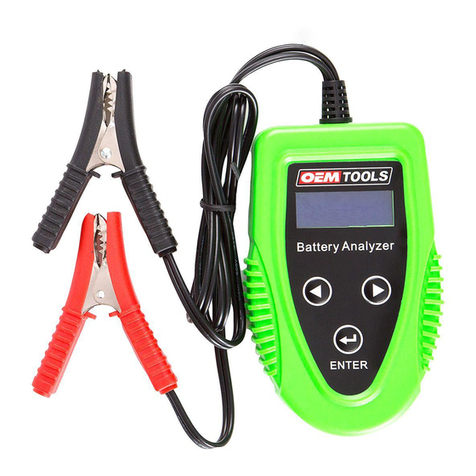
5
Operating Instructions and Parts Manual 24369
DIGITAL BATTERY
ANALYZER
• IF BATTERY ACID COMES INTO CONTACT WITH
SKIN OR THE CLOTHES, IMMEDIATELY WASH
WITH SOAP AND WATER. IF THE BATTERY ACID
GETS INTO EYES, RINSE EYES WITH WATER
RIGHT AWAY FOR AT LEAST 10 MINUTES THEN
GO TO THE HOSPITAL.
• This equipment is intended only for professional
use by personnel trained in performing the service
functions for which it is has been designed.
• This equipment is designed for servicing a variety
of vehicles in a safe, convenient manner. However,
differences in vehicle makes and models may make
it impossible to use this equipment as it is intended.
Do not attempt to force the use of this equipment
on an application for which it is not designed to
perform.
• The procedures documented in this manual are to
serve as guidelines for the use of this equipment.
• In addition to these guidelines, always follow the
manufacturer’s recommended procedures when
servicing each unique vehicle.
• The use of this equipment is simple and
straightforward if you follow the instructions. When
operating this equipment, use common sense, and
always stop to think before connecting the Battery
tester or performing any tests.
• Position cords to reduce risk of damage by hood,
door or moving engine parts.
• Stay clear of fan blades, belts, pulleys and other
moving parts that can cause injury to persons.
• Check polarity of battery posts.
THESE TEST PROCEDURES ARE FOR
NEGATIVE GROUNDED VEHICLES ONLY. FOR
POSITIVE GROUNDED VEHICLES, SEE VEHICLE
MANUFACTURER REPAIR MANUAL.
BATTERY TEST
1. Before you test a battery in a vehicle, turn off the
ignition, all accessories and loads.
2. Close all the vehicle doors and the trunk lid.
3. Determine which post of the battery is grounded
(connected) to the chassis.
4. Connect NEGATIVE (black) clip to vehicle chassis
or engine block away from the battery.
5. Connect POSITIVE (red) clip from battery tester to
POSITIVE (POS, P, +) ungrounded post of battery.
6. Do not connect clip to carburetor, fuel lines, or
sheet metal body parts. Connect to a heavy gauge
metal part of the frame or engine block.
Note: When disconnecting, remove clip from
vehicle chassis FIRST, then remove the clip from
the battery terminal.
7. Make sure you have put a 9V internal battery into
the tester’s battery chamber. If the LCD screen
shows “POWER LOW”, then the internal 9V battery
needs to be replaced . Replace it before starting
test. Note that nothing will be seen on the screen
until the tester is connected to a vehicle battery.
8. Press the “tu” button to select Battery Test. The
screen will show “BATTERY TYPE” selection.
Press the “t u” button to select the battery type:
REGULAR LIQUID, AGM BATTERY or VRLA/GEL
BATTERY.
9. Press “Enter” button to confirm choice.
10. The screen will show “RATING STANDARD”. Press
the “t u” button to select the battery standard:
SAE、DIN、IEC、EN or CA (MCA)
SAE: United States Standard
EN: European Standard
DIN: German Standard
IEC: International Electrical Science and
Technology Association
CA (MCA): Normal starting current or maritime
starting current
11. Press the “Enter” button to confirm the choice and
go to next step.
12. The screen will show “RATING CAPACITY”. Press
the “t u” button to select the battery capacity of
CCA. With each press of the button, the value will
increase or decrease 5 units.
13. This tester’s testing range:
SAE:、40 ~ 2,000 CCA
EN: 40 ~ 2,100 CCA
DIN:、25 ~ 1,300 CCA
IEC:、30 ~ 1,500 CCA
CA (MCA): 240 ~ 1,440 CA (MCA)
14. Press the “Enter” button to confirm the input value
of the battery capacity and begin the test.
15. The screen will show “TESTING”. Testing is in
progress. The test result will show up after 2
seconds.
16. If the tester asks “BATTERY CHARGED?”, press
the “t u” button to select “YES” or “NO”. Press
“Enter” button to confim choice and proceed to
the next step.
Note: The Tester will judge the battery status and
decide whether to show this Step or not, it doesn’t
appear every time.
05/15
2015 ©OEMTOOLS


























